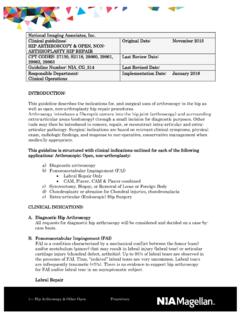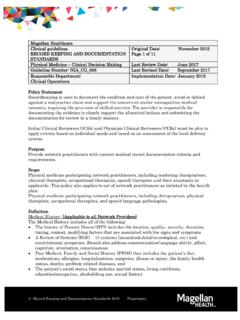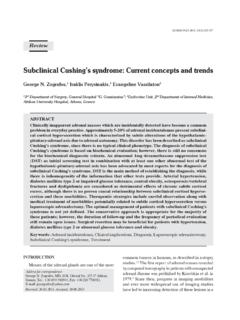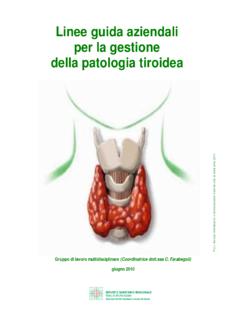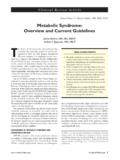Transcription of 2016 NIA Clinical Guidelines for Medical Necessity …
1 NIA Clinical Guidelines 2016 Magellan Health, Inc. Proprietary Page 1 of 75 2016 NIA Clinical Guidelines for Medical Necessity Review HORIZON NJ ULTRASOUND MANAGEMENT _____ NIA Clinical Guidelines 2016 Magellan Health, Inc. Proprietary Page 2 of 75 Guidelines for Clinical Review Determination Preamble NIA is committed to the philosophy of supporting safe and effective treatment for patients. The Medical Necessity criteria that follow are Guidelines for the provision of diagnostic imaging. These criteria are designed to guide both providers and reviewers to the most appropriate diagnostic tests based on a patient s unique circumstances.
2 In all cases, Clinical judgment consistent with the standards of good Medical practice will be used when applying the Guidelines . Guideline determinations are made based on the information provided at the time of the request. It is expected that Medical Necessity decisions may change as new information is provided or based on unique aspects of the patient s condition. The treating clinician has final authority and responsibility for treatment decisions regarding the care of the patient. Guideline Development Process These Medical Necessity criteria were developed by NIA for the purpose of making Clinical review determinations for requests for diagnostic tests. The developers of the criteria sets included representatives from the disciplines of radiology, internal medicine, nursing, and cardiology.
3 They were developed following a literature search pertaining to established Clinical Guidelines and accepted diagnostic imaging practices. All inquiries should be directed to: National Imaging Associates, Inc. 6950 Columbia Gateway Drive Columbia, MD 21046 Attn: NIA Associate Chief Medical Officer NIA Clinical Guidelines 2016 Magellan Health, Inc. Proprietary Page 3 of 75 TABLE OF CONTENTS TOC ULTRASOUND Guidelines _____ 4 76536 Head and Neck Ultrasound _____ 4 76700 Abdomen Ultrasound _____ 8 76856 Pelvic Ultrasound _____ 25 76870 Scrotum and Contents Ultrasound _____ 29 93880 Carotid Duplex Scan Ultrasound _____ 32 93886 Transcranial Doppler Ultrasound _____ 39 93925 Lower Extremity Arterial Duplex Scan _____ 44 93930 Upper Extremity Arterial Duplex Scan _____ 50 93970 Extremity Venous Duplex Scan _____ 53 93975 Abdominal, Pelvis, Scrotal, Retroperitoneal Organ Duplex Scan _____ 59 93978 Aorta, Inferior Vena Cava.
4 Iliac Duplex Scan _____ 65 93980 Penile Vessel Duplex Scan _____ 71 93990 Hemodialysis Access Duplex Scan _____ 73 _____ NIA Clinical Guidelines 2016 Magellan Health, Inc. Proprietary Page 4 of 75 TOC ULTRASOUND Guidelines 76536 Head and Neck Ultrasound CPT Codes: 76536 INTRODUCTION: Thyroid, parathyroid and lymph nodes are the most commonly imaged areas of the head and neck region and ultrasound is the most appropriated imaging modality.
5 Along with imaging minimally invasive procedures (fine needle aspiration) are performed on thyroid nodules clinically relevant lymph nodes and parathyroid. Besides the thyroid, parathyroid and lymph nodes, the salivary glands can be imaged. APPROPRIATE INDICATIONS FOR A HEAD OR NECK ULTRASOUND Thyroid Gland: To assist in diagnosing thyroid autoimmune disease. As a diagnostic tool for individuals with: o Thyroid nodules identified via palpation o Unexplained cervical adenopathy o Past history of radiation in the cervical region (annually) o Family history of carcinoma of the thyroid gland (annually) Evaluation of abnormalities detected by other imaging examinations. Staging tumors of the thyroid.
6 Monitoring the thyroid bed and cervical nodal compartments after thyroidectomy. Parathyroid Gland: To localize adenomas in preparation for surgery. Salivary Gland: To localize and identify lesions within the submandibular salivary gland or superficial lobes of the parotid. To determine benign vs. malignant tumors. Sialolithiasis For suspected abscess Cervical Lymph Nodes: To identify the size and complexity of cervical lymph nodes To differentiate benign vs. malignant nodes, although additional cytology may be needed to identify histological origin Mass Evaluation of undiagnosed mass. Other Indication: Follow up of an abnormality seen on prior imaging _____ NIA Clinical Guidelines 2016 Magellan Health, Inc.
7 Proprietary Page 5 of 75 ADDITIONAL INFORMATION RELATED TO HEAD AND NECK ULTRASOUND Thyroid Gland Ultrasound (US) of the thyroid gland is indicated to identify thyrotoxicosis, decipher between a benign versus malignant nodule present in or around the gland, and monitor disease progression or response to treatment. Parathyroid Gland When hyperparathyroidism is identified clinically, US of the parathyroid gland is used to localize adenomas in preparation for surgery. US appears to be the test of choice for this preoperative procedure, due in part to the fact that US is relatively inexpensive and does not emit radiating ions, but also because there is fair evidence that US is as effective at locating the lesion as the other standard imaging technique, nuclear scintigraphy.
8 Salivary Glands Uses of US in imaging of the salivary glands are similar to those of the thyroid and parathyroid glands: to identify and/or localize masses or lesions and to assess for pathology. Because of the anatomical location of the salivary glands, only the most superficial regions can be visualized by US, namely the submandibular gland, the sublingual gland, and the superficial lobes of the parotid gland. The deep lobe of the parotid, as well as the minor salivary glands, is unable to be visualized by US. For these regions, MRI or CT is recommended as first line diagnostic modalities. US is also used to stage Sjogren s disease. Masses of unknown origin In diagnosing head and neck masses or swellings of unknown origin, US can assist in making the initial diagnosis.
9 REFERENCES Ahuja, , Ying, M., Ho, , Antonio, G., Lee, , King, , & Wong, (2008). Ultrasound of malignant cervical lymph nodes. Cancer Imaging, 8, 48-56. Alyas, F., Lewis, K., Williams, M., Moody, , Wong, , Ahuja, , & Howlett, (2005). Diseases of the submandibular gland as demonstrated using high resolution ultrasound. Br J Radiol, 78, 362-9. doi: American Association of Clinical Endocrinologists (AACE) and Associazione Medici Endocrinologist (AME). (2010). Medical Guidelines for Clinical Practice for the Diagnosis and Management of Thyroid Nodules. Retrieved from American Institute of Ultrasound in Medicine (AIUM). (2013). AIUM Practice Guideline for the Performance of a Thyroid and Parathyroid Ultrasound Examination.
10 Retrieved from American Thyroid Association (ATA). (2009). Revised American Thyroid Association Management Guidelines for Patients with Thyroid Nodules and Differentiated Thyroid Cancer. Retrieved from Burke, , Thomas, , & Howlett, D. (2011). Imaging the major salivary glands. Br J Oral Maxillofac Surg., 49, 261-9. _____ NIA Clinical Guidelines 2016 Magellan Health, Inc. Proprietary Page 6 of 75 Chandak, R., Degwekar, S., Bhowte, , Motwani, M., Banode, P., Chandak, M., & Rawlani, S. (2011). An evaluation of efficacy of ultrasonography in the diagnosis of head and neck swellings. Dentomaxillofacial Radiol. 40, 213-21.
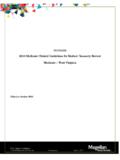
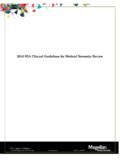
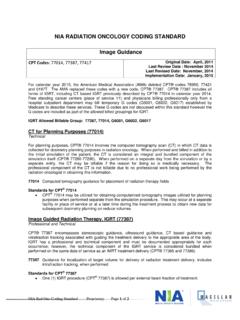
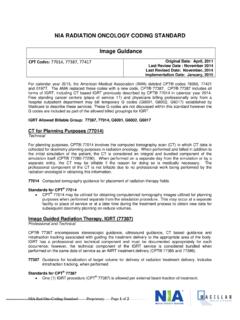

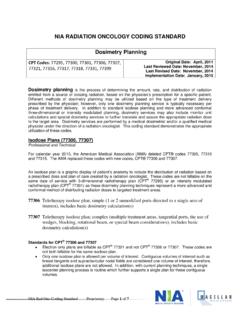
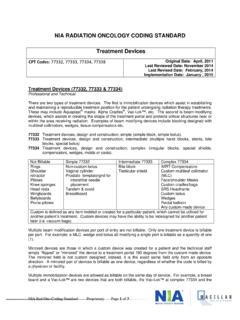
![Sleep Solution for [Health Plan] Members - RADMD-HOME](/cache/preview/f/e/0/e/6/2/1/8/thumb-fe0e6218ba49aea2ca3bc8bae4bee357.jpg)
